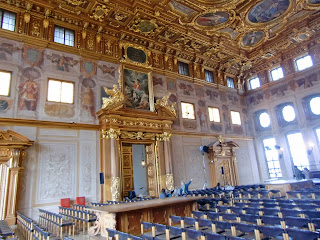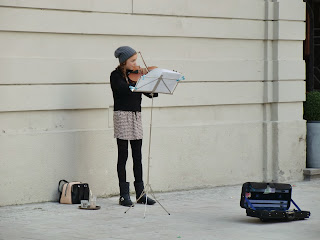A year in Paris doesn't mean staying in Paris all the time. We took a trip at the beginning of November to Augsburg, Germany to visit a colleague's research lab at Augsburg University. Augsburg is a small city in Bavaria about an hour by car from Munich, Germany. We took the TGV high speed train from Paris to Augsburg and arrived on a Friday night. We had the weekend to see the city, but after that we were busy with seminars, talking to our colleagues and talking with graduate students about their research. We did have a number of delightful dinners--see below for more.
Augsburg is a very old city (from Roman times around 15 BCE) and a very lovely one. The city hall (Rathaus in German) below is an example of the typical architecture of the city.
Inside of the rathaus is the Goldener Saal (Golden Room) which was part of the building when built in the 1600s. It is quite remarkable, as is one of the Prince's rooms, one of the side rooms off this amazing room.
This part of the Rathaus is used for concerts! Much of Augsburg was heavily damaged in WW2 (as it was the site of the Messerschmidt airplane factories, which the Allies bombed to considerable damage and also therefore much of the city). The Rathaus and these rooms were restored with meticulous hand crafting after WW2.
In the basement of the Rathaus is the Ratskeller ("keller" means "basement" in German). In many German cities that space is usually a bar or restaurant. In Augsburg it's a really terrific restaurant with authentic German food (and pizza!) and beer.
It's not a basement looking room at all! We had two delicious dinners there (we went back cuz we liked it so much).
Augsburg has a series of very small canals (from Roman times), that are not large enough to carry boats, but which you can find as you wander about the city. Below is one of the larger parts of the water system, and one of the very small ones with a lovely little fountain in front of a small bridge that leads to someone's door!

The city has a number of plazas that have tables for serving meals for the various restaurants. Here's Chuck relaxing at lunch in our table in the St. Moritz Platz and another view of the same spot to one of the many church towers in Augsburg.
It was a beautiful, warm and sunny Saturday when we wandered around. That was the only non-rainy and warm day of our week long trip!
Augsburg has many large churches. The one below is next to the Rathaus. It also happened to be above our little hotel, which was a quite lovely place with a delicious breakfast.
Most of the church towers have bells, as does the Perlner Tower. It begins at 7 am and rings bells (loudly) every 15 minutes til 10 pm in addition to two other churches nearby. Needless to say we did not sleep in and did not need an alarm clock to get up each day!
Among the other plazas of the city is the Fugger Platz ("platz" means "plaza" in German).
In the Fugger Platz on Saturday was this young lady, all of 14 years old (as I learned from a nice Augsburg lady), who has a great career coming in music. She played for an hour, and her abilities were astonishing. So lovely to listen to.
On my morning walks before going to the university, I found other interesting architectural additions. See the building corners below.

I also found a number of fascinating signs, one of which is here. And also wonderful doors.


This last door is one of the doors of the Rathaus.
We toured a unique place in Augsburg, the Fuggerei, a social community for poor Catholic citizens started by Jakob Fugger, a wealthy merchant, in the 1500s. The social community (which is a series of reasonable-sized single floor apartments) was the home to many people including the grandfather of Mozart! It is still in use today, and residents pay less than a euro a year to live there, but they must say prayers daily for the souls of the deceased members of the Fugger family. The Fugger family prospered over the centuries, and even today it is in business (private banking). The head of the family is a duke by heredity, although dukes no longer are political titles in Germany.
Below is the entry gate to this community and the fountain is not just a lovely fountain as it served as the water source in olden times for the community.
We also visited the oldest synagogue in Augsburg, which houses a museum of the Jewish community of Augsburg, has a full sanctuary that is used for High Holiday services and has ground floor rooms that are used for various community functions. The Jewish community is Augsburg is active and has many Jews from Eastern Europe. For security reasons, we could not take photos of the synagogue. However, here's a photo from the web of the exterior of the building--the dome is the dome of the synagogue sanctuary.
A few more views of the city, this one of the signs of autumn, and the one below is of one of the old gates of the city, which date back many centuries.

And lastly a very colorful building in the city not far from the Rathaus. Most of Augsburg has more
modern and less remarkable buildings than the ones in my photos, but the ones shown make Augsburg a picturesque and wonderful place to visit.























.jpg)









































